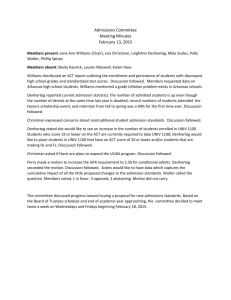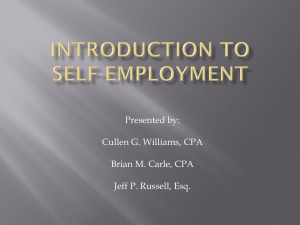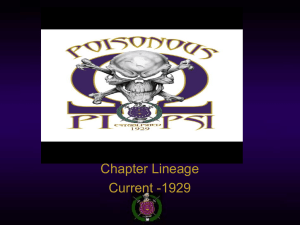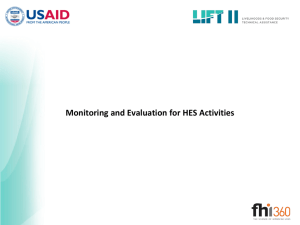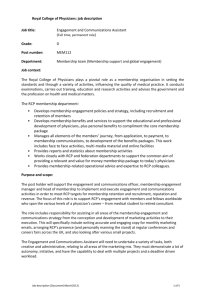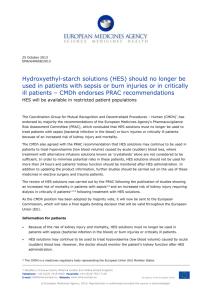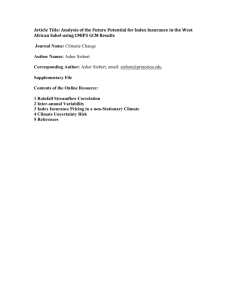RCP Health Informatics Unit - Royal College of Physicians
advertisement
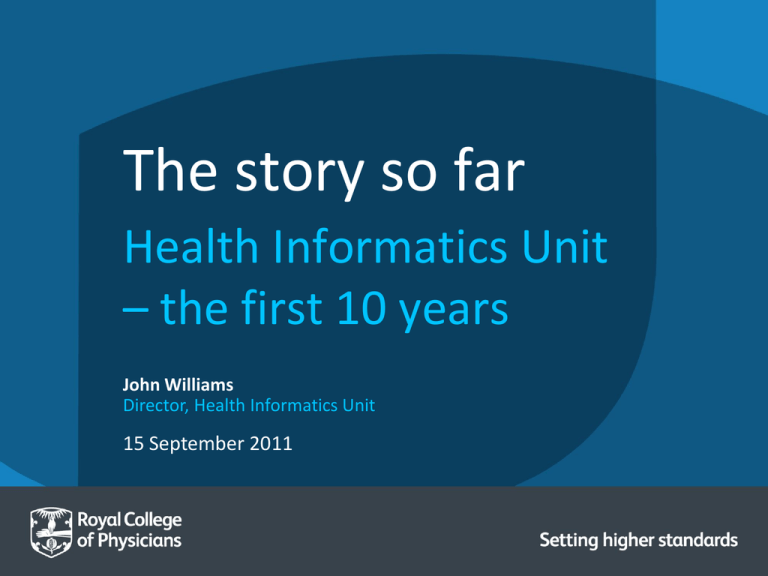
The story so far Health Informatics Unit – the first 10 years John Williams Director, Health Informatics Unit 15 September 2011 Overview Where we are now: – A brief review of the work of the RCP HIU Where we are going: – A look to the future RCP Health Informatics Unit: our mission To improve and develop the recording and communication of information about patients so that this effectively and safely supports a wide variety of purposes These purposes include – support for patient care (primary purpose) – source of data for aggregate analysis (secondary uses) This mission applies to both paper and electronic patient records and communications RCP Health Informatics Unit 2001-3: Reviewed quality of data derived from records (Literature review) Williams JG, Mann RY. Hospital Episode Statistics: time for clinicians to get involved? Clinical Medicine 2002;2(1):34-7. Mann R, Williams J. Standards in medical record keeping Clinical Medicine 2003;3:329-32. RCP Health Informatics Unit 2001-3: Reviewed quality of data derived from records (Literature review) Williams JG, Mann RY. Hospital Episode Statistics: time for clinicians to get involved? Clinical Medicine 2002;2(1):34-7. Mann R, Williams J. Standards in medical record keeping Clinical Medicine 2003;3:329-32. 2004-7: Worked with consultants in England &Wales to improve the quality and use of clinical data (iLab Project) Croft GP, Williams JG Breaking the cycle of poor data quality Clinical Medicine 2005;5:47-49. Croft GP, Williams JG, Mann RY, Cohen D, Phillips CJ. Can hospital episode statistics support appraisal and revalidation? Randomised study of physician attitudes. Clinical Medicine 2007;7:332-8. WELSH GOVERNMENT Hosted by Health Solutions Wales (HSW) Validity/value of HES/PEDW HES PEDW HES/PEDW are inappropriate for ‘clinical’ purposes at a local level – Missing or incorrect episodes, diagnoses and procedures Williams JG & Mann RY Hospital Episode Statistics: time for clinicians to get involved? Clinical Medicine 2002;2(1):34-7. – Poor timeliness – long delay before the data are available – Poor attribution of data to individual professionals – Insufficient clinical depth – only diagnosis & procedures Croft GP et al The RCP Information Laboratory: breaking the cycle of poor data quality Clinical Medicine 2005;5: 47-9 Croft GP et al Can hospital episode statistics support appraisal and revalidation? Clinical Medicine 2007;7:332-8 HES/PEDW are not useful for national audit Roberts SE et al Feasibility of using routinely collected inpatient data to monitor quality and inform choice: a case study using the UK Inflammatory Bowel Disease audit. Frontline Gastroenterology 2011;2:153-9. HES/PEDW are of value at a population level Roberts SE et al Hospital admission for ulcerative colitis and Crohn’s disease in England: comparison of mortality with and without colectomy. BMJ 2007;335:1033-36. Button LA et al Hospitalised incidence and case fatality for upper gastrointestinal bleeding from 1999 to 2007: A record linkage study. Alimentary Pharmacology & Therapeutics 2011;33:64-76 Data item in audit proforma % in HES/ or PEDW Primary reason for admission 84 Source of admission 71 Specialty of care in first 24 hours 52 Major co-morbidities recorded 39 Surgery performed 84 Indication for surgery 0 Post surgery complications 0 In hospital death 91 Why these problems? • • • • • • • Data is recorded in poorly structured paper records Clinical content is not standardised Clinical terms are not defined Haphazard scrutiny of record content by seniors No requirement for clinical validation before returns are made Coding rules are inappropriate – eg ‘impression’ Data is coded in classifications that lack clinical granularity (ICD-10 & OPCS-4) • Information Departments are focused on meeting the needs of the organisation rather than clinicians • Dataset is too limited from a clinical perspective: only diagnosis and procedures; no clinical data on out-patients Can HES/PEDW be improved? Yes, in the short-term, with greater attention to clear documentation of diagnoses and procedures No, in the long-term, without radical changes to the current dataset and process for collection RCP Health Informatics Unit 2007-9: Developed standards for structure and content of medical records (Admission records, handover & discharge) Carpenter I, Bridgelal-Ram M, Croft G, Williams J. Medical records and record-keeping standards. Clinical Medicine 2007;7:328-31. Carpenter I, Bridgelal-Ram M, Williams JG. A Clinician’s Guide to Record Standards Parts 1 and 2. Royal College of Physicians, London 2008. Clinical Record Standards •Evidence and consensus based standards for the structure and content of admission records, handover & discharge communications •Endorsed by the Academy of Medical Royal Colleges; DH; GMC; CQC; NICE; NHSLA; Medical Schools Council; Postgraduate Deans http://www.rcplondon.ac.uk/resources/clinical-resources/standards-medical-record-keeping http://www.connectingforhealth.nhs.uk/systemsandservices/clinrecords/24hour Clinical Record Standards Current work is addressing ambulatory care: – Scoping the contexts in which contact with hospitals occur – Identifying the information needs of these contacts – Developing generic standards for the structure and content of the record Other work – Refining the standards for the admission record – Developing editorial principles to ensure sustainability – Consulting on a core set of common data items http://www.rcplondon.ac.uk/policy/improving-healthcare/health-informatics The long-term vision...... To achieve, in ten years – – – – Patient focused electronic records Nationally standardised structure and content Primary source of valid data for aggregate analysis Appropriate patient access to personal information This vision has been – Endorsed by RCP Council – Adopted by Academy of Medical Royal Colleges – Acknowledged by DH – Supported by statutory bodies http://tinyurl.com/AoMRCVisionStatement Adam Fujinon Ascribe Scorpio Endosoft KeyMed (Olympus) Unisoft Endoeasy GI-Trac Weblogik EMS Locally developed solutions Diabetes Hypertension GORD Arthritis Out-patients The patient focused record Procedures Mrs Jones In-patients Specialist nurse telephone support In summary A 10 year vision for hospital patient records Electronic records focused on the patient, not the disease, intervention or context Clinical data conforming to national standards for structure and content Data captured at the point of care used as primary source of aggregate information for many purposes Greater patient access and control Endorsed by the Academy of Medical Royal Colleges Supported by a broad spectrum of national organisations http://tinyurl.com/AoMRCVisionStatement A big thank you to all who HIU staff who have contributed to this work over the last ten years Robin Mann Valerie Porter Janis Huston Shaibal Roy David Warmate John Ramage Sean Preston Giles Croft Caroline Brooks Lucy Payne Mala Bridgelal Ram Iain Carpenter Helen Fogarty Jibby Medina Darren Wooldridge .. and of course to all those individuals and organisations who have supported or worked with us
